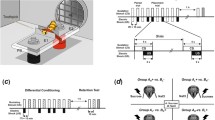Abstract
RECENT work has identified a neuron with widespread projections to odour processing regions of the honeybee brain whose activity represents the reward value of gustatory stimuli1,2. We have constructed a model of bee foraging in uncertain environments based on this type of neuron and a predictive form of hebbian synaptic plasticity. The model uses visual input from a simulated three-dimensional world and accounts for a wide range of experiments on bee learning during foraging, including risk aversion. The predictive model shows how neuromodulatory influences can be used to bias actions and control synaptic plasticity in a way that goes beyond standard correlational mechanisms. Although several behavioural models of conditioning in bees have been proposed3–7, this model is based on the neural substrate and was tested in a simulation of bee flight.
Similar content being viewed by others
References
Hammer, M. Nature 366, 59–63 (1993).
Hammer, M. & Menzel, R. J. Neuroscience 15, 1617–1630 (1995).
Couvillon, P. A. & Bitterman, M. E. Anim. Leam. Behav. 13, 246–252 (1985).
Couvillon, P. A. & Bitterman, M. E. Anim. Leam. Behav. 14, 225–231 (1986).
Couvillon, P. A., Lee, Y. & Bitterman, M. E. Anim. Leam. Behav. 19, 381–387 (1991).
Greggers, U. & Menzel, M. Behav. Ecol. Sociobiol. 32, 17–29 (1993).
Menzel, R., Greggers, U. & Hammer, M. in Insect Learning: Ecology and Evolutionary Perspectives (eds Papaj, D. R. & Lewis, A. C.) 79–125 (Chapman and Hall, London. 1993).
Real, L. A. Science 253, 980–986 (1991).
Real, L. A. Ecology 62, 20–26 (1981).
Harder, L. D. & Real, L. A. Ecology 68, 1104–1108 (1987).
Real, L. A., Ellner, S. & Harder, L. D. Ecology 71 1625–1628 (1990).
Beny, D. A. & Fristedt, B. Bandit Problems: Sequential Allocation of Experiments (Chapman and Hall, London, 1985).
Krebs, J. R., Kacelnik, A. & Taylor, P. Nature 275, 27–31 (1978).
Montague, P. R., Dayan, P. Nowlan, S. J. Pouget, A. & Sejnowskl, T. J. in Advances in Neural Information Processing Systems 5 (eds Hanson, S. J., Cowan, J. D. & Giles, C. L.) 969–976 (Morgan Kaufmann, San Mateo, CA. 1993).
Montague, P. R. & Sejnowskl, T. J. Learn. Memory 1, 1–33 (1994).
Konorski, J. Conditioned Reflexes and Neuron Organization (Cambridge University Press, Cambridge, 1948).
Hebb, D. O. The Organization of Behavior (Wiley, New York, 1949).
Samuel, A. L. IBM. J. Res. Dev. 3, 211–229 (1959).
Sutton, R. S. & Barto, A. G. Psych. Rev. 88, 135–170 (1981).
Sutton, R. S. & Barto, A. G. in Learning and Computational Neuroscience (eds Gabriet, M. & Moore J. W.) 497–538 (MIT Press, Cambridge, MA. 1987).
Sutton, R. S. Machine Learn. 3, 9–44 (1988).
Barto, A. G. Sutton, R. S. & Watkins, C. J. C. H. Technical Report 89-95, (Computer and Information Science. University of Massachusetts. Amherst. MA. 1989).
Rescorla, R. A. & Wagner, A. R. in Classical Conditioning II: Current Research and Theory (eds Black, A. H. & Prokasy, W. H.) 64–69 (Appleton-Century-Crofts, New York, 1972).
Spudich, J. L. & Koshland, D. E. Proc. natn. Acad. Sci. U.S.A. 72, 710–713 (1975).
Lockery, S. R. & Kristan, W. B. J. comp. Physiol. 168, 165–177 (1991).
Goldstein, R. S. & Camhi, J. M. J. comp. Physiol. 168, 103–112 (1991).
Harris-Warrick, R. M., Coniglio, L. M., Barazangi, N., Guckenheimer, J. & Gueron, S. J. Neurosci. 15, 342–358 (1995).
Hammer, M. & Menzel, R. Soc. Neurosci. Abstr. 20, 582 (1994).
Schultz, W., Apicella, P. & Ljungberg, T. J. Neurosci. 13, 900–913 (1993).
Widrow, B. & Stearns, S. D. Adaptive Signal Processing (Prentice-Hall, Englewood Cliffs. 1985).
Author information
Authors and Affiliations
Rights and permissions
About this article
Cite this article
Montague, P., Dayan, P., Person, C. et al. Bee foraging in uncertain environments using predictive hebbian learning. Nature 377, 725–728 (1995). https://doi.org/10.1038/377725a0
Received:
Accepted:
Issue Date:
DOI: https://doi.org/10.1038/377725a0
- Springer Nature Limited
This article is cited by
-
Art-Rent Concept and Measure With Connections to an Evolving Economy
Journal of the Knowledge Economy (2023)
-
Decision-making: from neuroscience to neuroeconomics—an overview
Theory and Decision (2021)
-
Sensing Happiness in Senseless Information
Applied Research in Quality of Life (2021)
-
Control of synaptic plasticity in deep cortical networks
Nature Reviews Neuroscience (2018)
-
Brain control and information transfer
Experimental Brain Research (2015)





